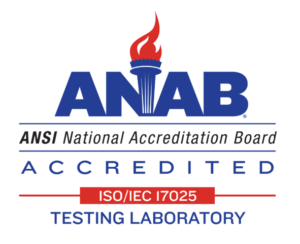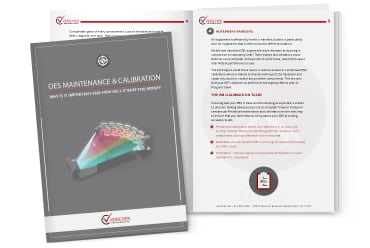PMI Testing Services
What is PMI Material Testing?
PMI, or Positive Material Identification, is a non-destructive test that verifies materials conform to the proper specifications and standards. This test can help prevent material failures due to the incorrect metals being used in the manufacturing process. By ensuring that the correct materials are used, PMI helps maintain the integrity and safety of products.
Accurate material identification is crucial across various industries, including aerospace, oil and gas, pharmaceuticals, and manufacturing. In these sectors, the use of incorrect materials can lead to catastrophic failures, safety hazards, and significant financial losses. PMI testing helps mitigate these risks by confirming the chemical composition of materials, ensuring they meet the required specifications and standards.
Verichek is ISO 17025 accredited for OES PMI Testing & Calibration.
Contact us for a copy of our certification.
We test to:
Segregate or sort a mix
For regulatory compliance
3rd party verification
Our PMI Calibration & Testing Services
Laboratory or Mobile Spark Analysis
This method is highly effective for detecting light elements such as carbon (C), sulfur (S), phosphorus (P), and boron (B), along with other elements. Spark analysis provides precise and detailed information about the material composition, making it ideal for applications requiring high accuracy. Whether performed in a laboratory setting or with mobile equipment on-site, spark analysis ensures that materials meet stringent quality standards.
Mobile Arc Sorting
Mobile arc sorting is a versatile PMI method used for rapid on-site material identification and sorting. This technique is particularly useful in industrial environments where quick decisions are necessary. It provides reliable results for a wide range of elements, helping to streamline processes and reduce downtime by ensuring the correct materials are used in production.
Handheld XRF Alloy Grade Identification
Handheld XRF (X-ray fluorescence) devices are portable and user-friendly, allowing for quick and efficient alloy grade identification in the field. This method is perfect for verifying the composition of various metal alloys, providing immediate results and ensuring compliance with industry standards. Handheld XRF is widely used in industries such as manufacturing, construction, and scrap metal recycling.
We Incorporate a Variety of PMI Equipment
Depending on the project, we use various pieces of equipment to perform PMI testing.
HANDHELD XRF
XRF is the fastest and easiest way to get grade identification information in the field. XRF operators need minimal training to operate the equipment properly or very little surface preparation to get results.
XRF produces qualitative and quantitative results but it cannot provide the operator with Carbon results or other light elements. When testing Low Alloy Steel it can tell the operator the material tested is a 41xx series alloy or 316, but without being able to analyze light elements such as Carbon, Nitrogen, Boron etc. it can’t provide the operator with the entire analytical chemistry.
Handheld LIBS
LIBS (laser induced breakdown spectroscopy) is the fastest metals analyser available. Can be used to identify a wide array of alloys including aluminum, magnesium, titanium, cobalt, chromium, nickel and copper,as well as stainless steels, tool steels and low allow steels and more
MOBILE OES
Mobile OES a quantitative process when operated in Spark Mode. The instrument emits an electrical charge which excites the metal’s surface into a plasma, causing light to be emitted and analyzed based on a percentage of the material’s chemistry.
Mobile OES is the only tool for conducting Carbon Equivalent (CE) analysis, full product chemistry documentation for API RP 578 or API RP 939C.
PMI LIBS vs OES
Understanding the strengths and applications of Laser-Induced Breakdown Spectroscopy (LIBS) and Optical Emission Spectroscopy (OES) is crucial for selecting the right PMI method.
PMI LIBS:
Strengths:
- Speed: Provides instantaneous results.
- Portability: Lightweight and easy to use in the field.
- Versatility: Analyzes a wide range of elements, including light elements.
- Minimal Sample Preparation: Requires little to no sample preparation.
Applications:
- Field Analysis: Ideal for on-site analysis in mining, recycling, and environmental monitoring.
- Quality Control: Used for rapid quality checks in manufacturing.
- Research and Development: Valuable for analyzing new materials.
PMI OES:
Strengths:
- Accuracy: Highly precise in detecting and quantifying elements.
- Comprehensive Analysis: Provides detailed chemical composition.
- Established Technology: Widely used with a proven track record.
- High Sensitivity: Sensitive to small variations in composition.
Applications:
- Laboratory Analysis: Suitable for detailed material analysis and research.
- Industrial Quality Control: Used in aerospace, automotive, and petrochemical industries.
- Compliance Testing: Ensures compliance with industry standards.
Contact us today to determine the best PMI method for your needs and ensure the quality and compliance of your materials.
PMI Testing Methods and Specifications
PMI (Positive Material Identification) testing encompasses various methods, each suited for specific material analysis requirements:
Handheld X-Ray Fluorescence (XRF) Analysis
Common for on-site, non-destructive testing, providing quick qualitative and semi-quantitative analysis. Ideal for verifying alloy composition but limited in detecting light elements like carbon.
Optical Emission Spectroscopy (OES)
Offers detailed chemical composition analysis, including light elements. Essential for applications needing comprehensive material characterization.
Laboratory/Mobile Spark Analysis
Utilized for analyzing light elements, adaptable for both laboratory and field settings.
Mobile Arc Sorting
Effective for on-the-go sorting of different alloys, especially in mobile or field environments.
Why Choose Us for Your PMI Testing Services?
-
Our PMI Testing Services stand out for several key reasons, combining both quality and compliance standards with customized testing solutions.
We are committed to the highest quality standards in material testing, ensuring reliability and accuracy in our PMI testing services.
We offer tailored PMI calibration and testing services. Whether it’s for a handful of samples or large-scale testing, we adapt our services to meet your specific needs.
Our services are flexible, offering both in-house and on-site testing options. We can efficiently handle small components as well as large complex parts.
In-House and On-site PMI Testing Options
All of our metal analysis testing services are customized to your needs. Depending on the number of pieces and the size and weight, you might be able to send the metal that needs PMI Testing to our in-house metal testing lab or require us to perform on-site testing visit.
In-House PMI Testing
Our In-House PMI Testing Service is perfect for customers that need a few samples tested. We routinely test samples for customers with as few as 1 sample to over 100 pieces depending on size and weight. Our in-house metal analysis lab provides quick turnaround time and accurate results to fit customer requirements.
IN-HOUSE PMI ADVANTAGES
Our In-House PMI Testing has some advantages over On-Site PMI Testing Services:
Cost effective – quick turnaround time
We have a controlled lab setting
Access to a vast library of control/verification standards
We have all the tools for whatever the job requires at our fingertips
We have access to a greater supply of resources (Argon, Batteries, Adapters, Etc)
On-Site PMI Testing
On-Site PMI Testing is for customers with greater than 100 pieces which need to be tested, the size and weight of the pieces are cost prohibitive to ship or the parts are installed and cannot be removed. Our On-site PMI analysis is a cost-effective solution for you when In-House PMI Testing proves to be prohibitive. Once a Purchase Order (PO) is received, Verichek dispatches a technician along with the necessary equipment to perform the testing.
We use the following Types of PMI Equipment:
Depending on the project, we use various pieces of equipment to perform PMI testing.
Handheld XRF or HHXRF
HHXRF is the fastest and easiest way to get grade identification information in the field. HHXRF operators need minimal training to operate the equipment properly or very little surface preparation to get results.
HHXRF produces qualitative and quantitative results but it cannot provide the operator with Carbon results or other light elements. When testing Low Alloy Steel it can tell the operator the material tested is a 41xx series alloy or 316, but without being able to analyze light elements such as Carbon, Nitrogen, Boron etc. it can’t provide the operator with the entire analytical chemistry.
Mobile OES
Mobile OES a quantitative process when operated in Spark Mode. The instrument emits an electrical charge which excites the metal’s surface into a plasma, causing light to be emitted and analyzed based on a percentage of the material’s chemistry.
Mobile OES is the only tool for conducting Carbon Equivalent (CE) analysis, full product chemistry documentation for API RP 578 or API RP 939C.
And we use the following testing techniques:
Laboratory or Mobile Spark analysis for light elements such as C, S, P, B along with other elements
Mobile Arc sorting
Handheld XRF alloy grade identification
Visual spark testing




 OES MAINTENANCE & CALIBRATION:
OES MAINTENANCE & CALIBRATION: